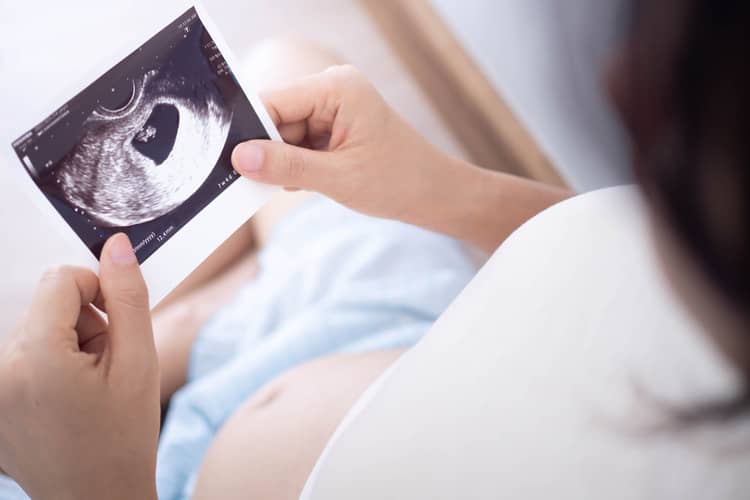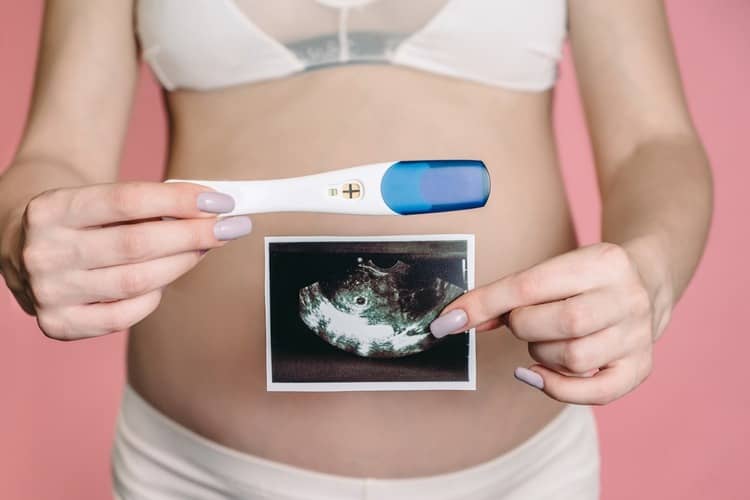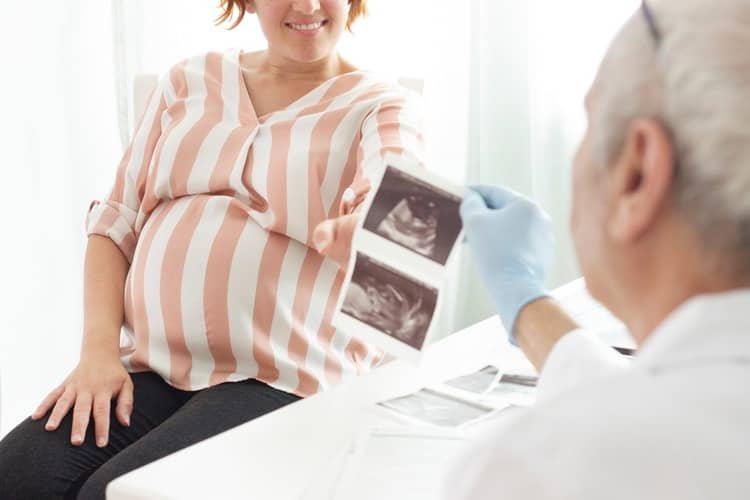
The first ultrasound in pregnancy is done in the 12th week
Every woman looking forward to the arrival of her offspring dreams of a problem-free pregnancy resulting in a healthy and viable baby. In order for a woman to be sure of the correct progress of her pregnancy, it is ideal and recommended to undergo gynecological examinations, which will provide her with the necessary information. The most important part of regular check-ups with a doctor is an ultrasound.
If you are interested in detailed information about how often to undergo an ultrasound during pregnancy, what types of examinations we know and what ultrasound examinations consist of in individual trimesters of pregnancy, read our article on the topic of ultrasound examinations during pregnancy.
The importance of ultrasound in pregnancy
Ultrasound examinations during pregnancy are definitely the most essential part of medical examinations during pregnancy. It can reveal and indicate a large amount of important information regarding the health of a pregnant woman, but especially the fetus developing in her belly. Findings from ultrasound are long-term helpful in terms of caring for the mother throughout the pregnancy until delivery.
The way the baby is born depends on the development of individual ultrasound examinations during pregnancy. This means that the doctor, based on the findings from the ultrasound, decides on the safest method of delivery for both the mother and the baby.

Types of ultrasound examinations
We distinguish between two types of ultrasound examinations. While the best-known and most common examination during pregnancy is an ultrasound through the abdomen, a transvaginal ultrasound is performed at the beginning of pregnancy, when the fetus is observed in this way and the exact length of the pregnancy is determined.
Examination through the vagina can be performed safely up to a certain point in pregnancy, approximately up to the third month. Unfortunately, this method is often used to determine the progress of the abortion in the first weeks of pregnancy. Transvaginal ultrasound in pregnancy works on the principle of carefully inserting a thin oblong ultrasound probe into the vagina of a pregnant woman.
It is a painless, but unpleasant examination, the essential part of which is, for hygienic reasons, a condom stretched over the probe itself, which subsequently offers a view of the inside of the female genital organs. This examination is also used during routine gynecological examinations.
Abdominal ultrasound during pregnancy is part of the three main pregnancy examinations performed using ultrasound, while the principle is quite simple. The gynecologist applies a transparent gel to the abdomen of the pregnant woman, which increases the conductivity of the ultrasound, and thus facilitates the entire process consisting of gently passing the probe along the abdominal wall.
How often is an ultrasound done during pregnancy?
In Slovakia, there is a "10, 20, 30" rule among doctors in terms of ultrasound screening, based on which pregnant women should undergo the examination in the specified weeks. Usually, however, the first ultrasound during pregnancy is moved from the tenth week to the 11th to 14th week of pregnancy, while the second in order offers a range from the 20th to the 22nd week. The third ultrasound examination is performed at the fixed date of the 30th week of pregnancy.
Doctors justify such postponement of the ultrasound to later weeks in the case of the first and second ultrasound by the fact that even one or two extra weeks can help them to be able to provide the pregnant woman with much more necessary information. As for the duration of the examination, it falls between 10 and 30 minutes.

When is the first ultrasound done during pregnancy?
We have already clarified above when to go for the first ultrasound during pregnancy. This method of visiting a doctor for an ultrasound examination at a fixed date during the first trimester of pregnancy was set up by English experts who determined that at the time of the first ultrasound examination the baby should have an ideal size of between 45 and 85 millimeters.
Among the main points that the doctor focuses on during this examination, first of all, is the confirmation of the frequency of pregnancy, i.e. how many fetuses have taken hold in the uterus. It is also determined whether there has been a possible ectopic pregnancy, and based on the pulsating heart of the fetus, the doctor can determine its viability.
Based on the ultrasound image, the doctor can also determine the relatively accurate length of the woman's pregnancy during this period, which is subsequently reflected in any changes to the date of birth set before the ultrasound.
As part of the first ultrasound during pregnancy, the fetus is usually measured with the help of the ultrasound device itself, while the results of this measurement can largely confirm the presence of almost 50 percent of birth defects and diseases. During the ultrasound, doctors notice not only the presence of the nasal bone, but also any signs of the child's heart development defects.
As for hereditary diseases and examinations for them, during the large ultrasound in the 11th to 14th week of pregnancy, NT examination is also performed, and thus nuchal translucency. This consists in checking the accumulated liquid in the subcutaneous tissue of the fetus's head, on the basis of which it is possible to determine whether the baby suffers from Down's syndrome.
In the event that any potential difficulty in the development of the fetus is identified during the screening, the doctor should recommend the pregnant woman to another specialist for an ultrasound. This is mainly due to the fact that if any possible developmental defects are detected, it is better to have another pair of eyes look at the fetus.

The second ultrasound during pregnancy is the most important
The second examination with the help of ultrasound is also called a large ultrasound in pregnancy, while it is considered the main screening examination of a pregnant woman. From the point of view of the time horizon, there is again a certain range established by experts, during which it is advisable to undergo a second ultrasound. This is most often between the 19th and 22nd week, with many doctors preferring around the end of the 21st week of pregnancy.
The main screening is usually characterized as a genetic examination, because it is during it that the (absence) of chromosomal errors is checked. As for Down's syndrome, the presence of this congenital chromosomal defect can be confirmed during a large screening with greater certainty than during the first one.
This is mainly caused by the fact that within a few weeks of the first ultrasound, the child develops organs that can confirm the suspicion of Down's syndrome. Slight deviations can thus be identified by the doctor on the heart or renal pelvis of the fetus.
Also for this reason, a view of the individual organs of the developing fetus is a very important part of the second ultrasound examination. In this area of fetal growth, the doctor focuses on the structure of specific organs and the correctness of their development. The second ultrasound examination is therefore usually referred to as a morphological ultrasound during pregnancy. It focuses primarily on changes in the shape of the child's body.
In addition to Down's syndrome, doctors can detect the presence of other congenital diseases, such as Edwards' syndrome, which can be confirmed based on a specific hand position, or the positions of the fingers on the baby's hands.
In addition to the above-mentioned aspects, however, doctors also take into account the development of the child's central nervous system during a large ultrasound during pregnancy, which means that they focus on any possible deviations in terms of the size and shape of the brain, enlargement of the cerebral ventricles or congenital diseases of the spine.
Birth defects can be observed during the main screening and in the area of the digestive tract. Most often, these are signs of the umbilical cord entering the child's abdomen or kidneys. In all the mentioned cases, the doctor should send the patient to another specialist for re-screening in order to verify the correctness of his initial suspicion.
As part of the second, and thus the main ultrasound, it is already possible to determine the gender of the baby with greater certainty, but everything depends on the position in which the fetus is at that moment. Often, a baby can cover its genitals with its legs, on the basis of which the child's gender is naturally identified. Therefore, even in the second trimester, the detected gender may not be certain.
The essence of the third ultrasound in pregnancy
Between the 30th and 32nd week of pregnancy, the baby already assumes the prenatal position. This position can change at any time and in any way during the period before birth, but this is unlikely. Therefore, during the third ultrasound during pregnancy, doctors check the exact position of the fetus, while also determining its size, especially in terms of the circumference and diameter of the head.
The measurement also refers to the circumference of the baby's abdomen and femur. Based on all the measured values, the ultrasound software then determines the estimated weight of the baby with potential deviations of a few grams, thanks to which the doctors determine whether the development and growth of the baby is taking place correctly depending on the supplied nutrients and oxygen.
Proper nutrition of the fetus can also be confirmed by another test in the form of an image of blood flow through the umbilical cord, while the flow of nutrients and oxygen is also checked in the area of the baby's brain. The biggest identifier of a lack of nutrients is the limited physical activity of the fetus in the belly of a pregnant woman.
By limiting movement, the baby tries to conserve the supply of supplied nutrients, while its organism concentrates them primarily in the brain, which ensures its survival. Therefore, if a pregnant woman notices a persistently reduced rate of movement of the fetus in the abdomen during the later stages of pregnancy, it is a warning sign that something is wrong.
During the third large ultrasound, gynecologists check the position of the placenta. It should not be set too low, because it could create a potential obstacle during childbirth and thus complicate it.

Is ultrasound in pregnancy dangerous?
Ultrasound during pregnancy is a relatively safe examination. It is necessary to follow the standard procedures related to the set dates of individual ultrasound examinations. Every single ultrasound that a pregnant woman should undergo within nine months has a given time interval.
The specific weeks of pregnancy in which the ultrasound examination should be performed are derived from the gradual development of the baby, and they are recommended not only by Slovak gynecological societies, but also worldwide.
Therefore, if the ultrasound is performed at the right time, in a professional environment and especially with qualified devices, a woman does not have to worry about ultrasound during pregnancy at all. This is a very important and reliable examination that can reveal a lot about the course of pregnancy and the overall development of the baby.
The first ultrasound during pregnancy - experience
In connection with both types of ultrasounds, many rumors spread among women about the potential harmful effect on the fetus during the examination. It is mainly connected with the fact that the fetus can feel ultrasound waves in a certain way. However, many women confirmed on discussion forums that both transvaginal and abdominal ultrasound did not affect their offspring in any way.
In the first weeks, many underwent a transvaginal ultrasound in order to find out as much information as possible about their pregnancy, which the doctor could not yet give them through an ultrasound of the abdominal wall. The same applies to the main screenings during the individual trimesters of pregnancy. Undergoing examinations, of course, depends on the specific woman, but this step on the part of the mother is essential for the healthy development of the child.
The most frequent questions - FAQ
If you feel that you have not acquired the necessary knowledge after reading our article on ultrasound examinations in pregnancy, do not hesitate to turn to our question and answer section, where we have summarized several other aspects related to the mentioned topic. You can also use the available comments section, which is open for any questions from your side. We try to answer them in the shortest possible time.
What are the doctor's next steps after the first ultrasound in case of suspicion of Down's syndrome?
Is it possible to determine the gender of the baby during the first ultrasound during pregnancy?
When is the very last ultrasound during pregnancy?
Is it enough if I undergo only three main ultrasound examinations during pregnancy?
Why is it recommended not to have a bowel movement before the ultrasound?
Pridať komentár






